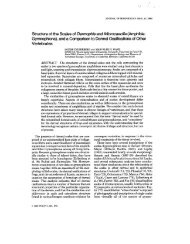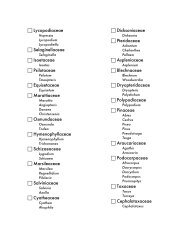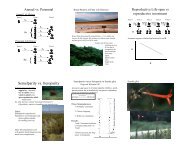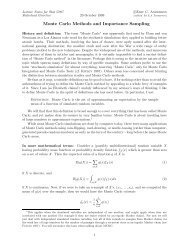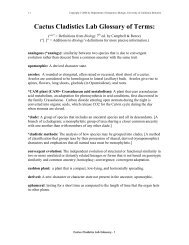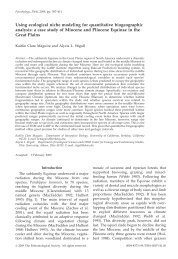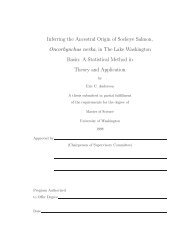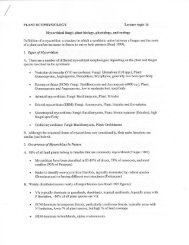Fungi, Algae and Bryophytes - Integrative Biology - University of ...
Fungi, Algae and Bryophytes - Integrative Biology - University of ...
Fungi, Algae and Bryophytes - Integrative Biology - University of ...
You also want an ePaper? Increase the reach of your titles
YUMPU automatically turns print PDFs into web optimized ePapers that Google loves.
2.3<br />
Copyright © 2008 by Department <strong>of</strong> <strong>Integrative</strong> <strong>Biology</strong>, <strong>University</strong> <strong>of</strong> California-Berkeley<br />
<strong>Fungi</strong>, <strong>Algae</strong> <strong>and</strong> <strong>Bryophytes</strong><br />
1. Read this lab text BEFORE coming to lab.<br />
Things To Do Before Lab<br />
2. Collect a small sample <strong>of</strong> a bryophyte somewhere on or near campus. Note the environmental<br />
conditions under which the organism was growing (moist, dry, sunny, etc.). Bring your sample to<br />
lab (you’ll use it to complete a graded assignment).<br />
3. There is a considerable amount <strong>of</strong> material in this lab. Your group must be prepared <strong>and</strong> work<br />
efficiently.<br />
Things To Bring To Lab<br />
Make sure you bring your textbook. The photos <strong>and</strong> figures will help in underst<strong>and</strong>ing the material<br />
in this lab.<br />
<strong>Fungi</strong>, <strong>Algae</strong> <strong>and</strong> <strong>Bryophytes</strong> - 1
Copyright © 2008 by Department <strong>of</strong> <strong>Integrative</strong> <strong>Biology</strong>, <strong>University</strong> <strong>of</strong> California-Berkeley<br />
Major Objectives <strong>of</strong> this Lab<br />
1. Underst<strong>and</strong> the distinguishing features <strong>of</strong> fungi, algae <strong>and</strong> plants.<br />
2. Underst<strong>and</strong> the concept <strong>of</strong> Alternation <strong>of</strong> Generations in plants.<br />
3. Identify the gametophyte <strong>and</strong> sporophyte generations in plants.<br />
4. Determine the features that facilitate or retard the movement <strong>of</strong> plants from water to a terrestrial<br />
environment.<br />
The <strong>Biology</strong> <strong>of</strong> <strong>Fungi</strong>, <strong>Algae</strong> <strong>and</strong> <strong>Bryophytes</strong><br />
In this lab, we will introduce you to some <strong>of</strong> the diversity <strong>of</strong> the <strong>Fungi</strong> as well as the so-called<br />
“primitive” or “lower” plants, the algae <strong>and</strong> the bryophytes. Although fungi have been traditionally<br />
grouped with plants, they are as distinct from algae <strong>and</strong> plants as they are from animals. In fact,<br />
current molecular studies indicate that fungi <strong>and</strong> animals arose from a common ancestor. The fungi<br />
<strong>and</strong> plants have no direct evolutionary connection <strong>and</strong> were derived independently from different<br />
groups <strong>of</strong> unicellular organisms. The algae can be divided into red algae, brown algae <strong>and</strong> green algae<br />
based on differences in their morphology, pigments <strong>and</strong> biochemistry. However, it is believed that<br />
the l<strong>and</strong> plants evolved from freshwater green algae. It is important to realize the relationships<br />
between these different groups <strong>of</strong> organisms. Once they were all grouped together but are now<br />
regarded as separate entities.<br />
<strong>Fungi</strong><br />
More than 100,000 species <strong>of</strong> fungi are known. <strong>Fungi</strong>, are heterotrophs <strong>and</strong> obtain their food as<br />
saprophytes or parasites. Saprobes obtain their nutrition by breaking down <strong>and</strong> feeding on dead or<br />
decaying organic matter. Thus, fungi are extremely important as decomposers which recycle nutrients<br />
back into the biosphere. These organisms are not photosynthetic (why, then were they once<br />
classified with the plants?).<br />
<strong>Fungi</strong> are primarily terrestrial, filamentous <strong>and</strong> possess a cell wall made <strong>of</strong> chitin which is similar to<br />
the polysaccharide found in the exoskeletons <strong>of</strong> arthropods. The majority <strong>of</strong> the fungi are usually<br />
composed <strong>of</strong> filaments known as hyphae (hypha = singular). Many hyphae, when joined together,<br />
form a mycelium (mycelia = plural). Mushrooms consist <strong>of</strong> densely packed hyphae. This filamentous<br />
form provides a high surface-to-volume ratio that greatly enhances its mode <strong>of</strong> nutrition.<br />
Rhizopus, or bread mold (Fig. 1.1) is a saprophytic fungus whose mycelium grows rapidly on<br />
bread <strong>and</strong> s<strong>of</strong>t fruits. At certain times the hyphae form sporangia, containing numerous black<br />
spores which are easily spread by the wind. These sporangia are the result <strong>of</strong> either asexual or<br />
sexual reproduction. <strong>Fungi</strong> are classified into four divisions (“phyla” in the animal kingdom)<br />
based on their sexual structures. Rhizopus are Zygomycetes (about 600 species known) with<br />
reference to the zygospores which they produce as result <strong>of</strong> sexual reproduction.<br />
<strong>Fungi</strong>, <strong>Algae</strong> <strong>and</strong> <strong>Bryophytes</strong> - 2
Fig. 1.1<br />
Life history <strong>of</strong> the bread mold Rhizopus.<br />
Copyright © 2008 by Department <strong>of</strong> <strong>Integrative</strong> <strong>Biology</strong>, <strong>University</strong> <strong>of</strong> California-Berkeley<br />
A beneficial species <strong>of</strong> terrestrial fungus is the common, store-bought edible mushroom Agaricus<br />
bisporous. The mushroom is the characteristic sexual reproductive structure <strong>of</strong> the Basidomycetes<br />
(about 25,000 species known). The hyphae making up the mushroom are dikaryotic (n+n) <strong>and</strong> form<br />
a diffuse mat hidden from view in substrates such as soil or rotting wood. In an open area the mycelium<br />
exp<strong>and</strong>s evenly in all directions <strong>and</strong> may grow as large as 100 feet in diameter. Mushrooms<br />
usually form at the outer edges <strong>of</strong> the mycelium because this is where the freshest nutritive material<br />
is located <strong>and</strong> hence the most active growth. As a consequence, mushrooms may be arranged in<br />
circular formation (the so-called “fairy rings” <strong>of</strong> legend). Mushrooms develop very quickly, sometimes<br />
overnight. This is possible because for a much longer period <strong>of</strong> time the hyphae were assimilating<br />
large amounts <strong>of</strong> food <strong>and</strong> producing new protoplasm underground.<br />
So far we have considered fungi in their roles as decomposers, <strong>and</strong> to a lesser extent, as food. However,<br />
fungi also play a significant role as human pathogens. Many skin <strong>and</strong> lung (pulmonary) diseases<br />
are caused by fungi. A common disease affecting the mucous membranes <strong>and</strong> the skin <strong>and</strong> nails is<br />
caused by the fungus C<strong>and</strong>ida albicans. This fungus is normally present in your environment <strong>and</strong><br />
benign. However, in certain circumstances C. albicans can cause human disease. For example,<br />
<strong>Fungi</strong>, <strong>Algae</strong> <strong>and</strong> <strong>Bryophytes</strong> - 3
Copyright © 2008 by Department <strong>of</strong> <strong>Integrative</strong> <strong>Biology</strong>, <strong>University</strong> <strong>of</strong> California-Berkeley<br />
vaginitis, involves infection <strong>of</strong> the mucous membrane <strong>of</strong> the female reproductive system by C.<br />
albicans. In the popular press, this disease is said to be caused by a “yeast”, but in fact, what we<br />
commonly call yeast (involved in beer <strong>and</strong> bread making) belongs to an entirely different group<br />
(Saccharomyces). Thus, popular advice that woman should avoid bread <strong>and</strong> other yeast-containing<br />
foods is in error. Note the cultures <strong>of</strong> C. albicans <strong>and</strong> as well photographs <strong>of</strong> other medically significant<br />
diseases caused by fungi. Both these “yeasts” are members <strong>of</strong> the Ascomycetes (over 60,000<br />
species known).<br />
The last major group <strong>of</strong> fungi are the Deuteromycetes or “<strong>Fungi</strong> Imperfecti” which form a miscellaneous<br />
assemblage <strong>of</strong> about 17,000 species <strong>of</strong> fungi in which the sexual reproductive features are not<br />
known. This division is artificial since most are clearly Ascomycetes, some are Basidiomycetes <strong>and</strong><br />
Zygomycetes based on their asexual reproductive structures.<br />
Penicillium is a Deuteromycete which was found to produce an antibiotic which could significantly<br />
retard the growth <strong>of</strong> other living organisms such as bacteria. This accidental discovery by<br />
Sir Alex<strong>and</strong>er Fleming in 1928 resulted in countless lives being saved. Many other<br />
Deuteromycetes are important as producers <strong>of</strong> antibiotics that are essential in the fight against<br />
disease pathogens.<br />
Saprolegnia (the fly fungus) is a water mold Once also classifed with the fungi, they are now<br />
grouped with the Stramenopiles (see Campbell, 5th Ed). This organism consists <strong>of</strong> many fine threadlike<br />
hyphae which appear as a white fuzzy growth on the body <strong>of</strong> the fly. Water molds have flagellated<br />
reproductive cells <strong>and</strong> are the cause <strong>of</strong> several major crop diseases, such as the mildews. Water<br />
molds are now part <strong>of</strong> the group known as the Stramenopiles.<br />
Slime molds - Once classified with fungi, the slime molds are now grouped with the Protista. Most<br />
slime molds live in cool, shady, moist places in the woods… on decaying logs, dead leaves <strong>and</strong> other<br />
damp organic matter. During its non-reproductive stage, a slime mold forms a large, multinucleate<br />
masses <strong>of</strong> streaming protoplasm known as a plasmodium (plural = plasmodia) which moves in an<br />
“amoeboid” fashion. As the plasmodium travels, it engulfs bacteria, yeast, fungal spores <strong>and</strong> small<br />
particles <strong>of</strong> decayed animal <strong>and</strong> plant matter. The ability to migrate exposes the plasmodium to new<br />
feeding areas. Depletion <strong>of</strong> the food supply stimulates movement. When food is in short supply, the<br />
plasmodium creeps to an exposed location <strong>and</strong> forms several masses <strong>of</strong> protoplasm, each <strong>of</strong> which<br />
develops into a sporangium consisting <strong>of</strong> a stalk <strong>and</strong> a sporangium in which spores are borne. Plasmodia<br />
come in a variety <strong>of</strong> colors <strong>and</strong> can be quite beautiful. It is probable that the pigments function<br />
as photoreceptors since only pigmented plasmodia require light for spore reproduction.<br />
Physarum, a typical slime mold, produces two macroscopic stages: 1) the vegetative plasmodium,<br />
<strong>and</strong> 2) the reproductive sporangium which contains numerous spores. Examine the rapid<br />
protoplasmic streaming within the “veins” <strong>of</strong> the plasmodium. Each vein is coated with a thick<br />
sheath <strong>of</strong> slime, hence the name slime mold.<br />
<strong>Fungi</strong>, <strong>Algae</strong> <strong>and</strong> <strong>Bryophytes</strong> - 4
<strong>Algae</strong><br />
Copyright © 2008 by Department <strong>of</strong> <strong>Integrative</strong> <strong>Biology</strong>, <strong>University</strong> <strong>of</strong> California-Berkeley<br />
The <strong>Algae</strong> are a diverse group <strong>of</strong> both unicellular <strong>and</strong> multicellular autotrophic organisms which<br />
have photosynthetic pigments. <strong>Algae</strong> are classified in part depending on the pigments they possess.<br />
We are concerned primarily with the green algae in this lab as they are the probable precursors to the<br />
l<strong>and</strong> plants. Green algae (7,000 species) have chlorophyll pigments which are identical to the ones<br />
found in plants. Members <strong>of</strong> the green algae range from the microscopic to several hundred feet in<br />
length <strong>and</strong> are mostly aquatic, most are found in freshwater habitats but many are marine. A few are<br />
terrestrial. Some are symbiotic with lichens, protozoa <strong>and</strong> even various invertebrates. You can also<br />
find green algae growing on the surfaces <strong>of</strong> tree trunks or branches.<br />
Spirogyra is a microscopic <strong>and</strong> filamentous green alga common in cool ponds where some<br />
movement <strong>of</strong> water occurs. It has a single spiral chloroplast in each cell. Pyrenoids, small round<br />
structures “decorate” the chloroplast. These store starch.<br />
Volvox is a microscopic <strong>and</strong> colonial green alga. This group includes spectacular colonies<br />
composed <strong>of</strong> 512 to 50,000 cells. Each colony is motile. Within some <strong>of</strong> the mature colonies<br />
you may find daughter colonies which are eventually liberated to form new mature colonies.<br />
Ulva, (known as sea lettuce), is a large green marine alga that is found along the Pacific coast. It<br />
has a sheetlike growth habit <strong>and</strong> is <strong>of</strong>ten found on rocks that are exposed at low tide. A holdfast<br />
anchors it to the substrate.<br />
Other common macroscopic marine algae fall within the group known as the brown algae (1,500<br />
species, mostly marine). Within this group are many <strong>of</strong> the familiar sea weeds, including the kelps.<br />
The brown algal body (thallus) takes on a range <strong>of</strong> forms <strong>and</strong> may be highly branched. Note that the<br />
thallus can <strong>of</strong>ten be subdivided into distinct regions: a holdfast, a stipe, a blade, <strong>and</strong> <strong>of</strong>ten a bladder. A<br />
bladder is an enlarged, hollow structure at the tip <strong>of</strong> a blade that allows it to float at or near the<br />
surface <strong>of</strong> the water. Examples <strong>of</strong> red algae (4,000 species, mostly marine) include the “sea weed”<br />
that is used for making sushi. Agar is an important commercial product made from red algae.<br />
Blue-green algae (cyanobacteria). The so-called blue-green algae are not actually algae. They are<br />
cyanobacteria, which as the name implies, indicates that they are actually autotrophic bacteria which<br />
are prokaryotes. Prokaryotes have no nuclear membrane <strong>and</strong> thus lack a defined nucleus. They<br />
possess chlorophyll <strong>and</strong> evolve oxygen via photosynthesis although their pigments are not bounded<br />
by membranes into organelles like chloroplasts. These organisms, or closely related ancestors, are<br />
responsible for the formation <strong>of</strong> our oxygen atmosphere. Thus, they were very important in the<br />
evolution <strong>of</strong> organisms having aerobic respiration. A currently discussed theory <strong>of</strong> the origin <strong>of</strong><br />
chloroplasts suggests that blue-green alga-like organisms became “incorporated” into cells <strong>of</strong> early<br />
plant progenitors <strong>and</strong> eventually evolved into chloroplasts. (Except for the blue-green algae the rest<br />
<strong>of</strong> the organisms we will study in today’s lab, including the fungi, the remainder <strong>of</strong> the algae, bryophytes<br />
<strong>and</strong> ferns are all eukaryotes, which have a defined nucleus).<br />
<strong>Fungi</strong>, <strong>Algae</strong> <strong>and</strong> <strong>Bryophytes</strong> - 5
Copyright © 2008 by Department <strong>of</strong> <strong>Integrative</strong> <strong>Biology</strong>, <strong>University</strong> <strong>of</strong> California-Berkeley<br />
Lichens. Lichens are mutualistic symbiotic associations between fungi <strong>and</strong> certain green algae or<br />
cyanobacteria. The fungus is usually an Ascomycete. Because <strong>of</strong> this symbiotic relationship, lichens<br />
are able to inhabit some <strong>of</strong> the harshest environments on earth. However, they are particularly<br />
sensitive to toxic compounds in the atmosphere. Thus they are natural indicators <strong>of</strong> polluted air.<br />
The L<strong>and</strong> Plants<br />
It is estimated that there are 250,000 to 300,000 species <strong>of</strong> l<strong>and</strong> plants on the earth at the present<br />
time. Although the plants most familiar to you have bodies composed <strong>of</strong> flowers, leaves, stems <strong>and</strong><br />
roots, some plants may not have all these structures. Tremendous variation is to be noted in size as<br />
well… plants range from tiny fern gametophytes to gigantic forest trees over 350 feet tall. Plants also<br />
vary in the ways they reproduce <strong>and</strong> in the way they obtain their food. Throughout this exercise <strong>and</strong><br />
subsequent ones you should ask yourself: “Why is this organism considered a plant? What characteristics<br />
does it show which includes this organism within the plants?”<br />
Besides having a waterpro<strong>of</strong> waxy cuticle layer that protects against desiccation, a layer <strong>of</strong> sterile<br />
(non-reproductive) cells protects the gamete producing cells (<strong>and</strong> embryo) <strong>of</strong> plants from<br />
drying out. Plants also have stomata (absent in liverworts <strong>and</strong> some mosses) that control the<br />
loss <strong>of</strong> water that result from necessary gaseous exchange for photosynthesis <strong>and</strong> respiration.<br />
Plants also share some features with their progenitors, the green algae in having chloroplast,<br />
food storage as starch <strong>and</strong> cell walls <strong>of</strong> cellulose.<br />
Botanists use many characteristics in order to arrange this great array <strong>of</strong> different organisms into an<br />
orderly system. Traits used include morphology, anatomy, cytology, biochemistry, physiology <strong>and</strong><br />
life cycle pattern. Whenever possible, fossil evidence is also used. One characteristic used to classify<br />
plants is their life cycle. Shown in Fig. 1.2 is an imaginary, complete life cycle. All the plants will<br />
exhibit this Alternations <strong>of</strong> Generations life cycle where the sporophyte <strong>and</strong> gametophyte differ in<br />
morphology.<br />
As you go through this <strong>and</strong> the next exercise, it will become apparent that there are major trends in<br />
life cycles as one moves from the “primitive” to the “advanced” plants. Make sure you know <strong>and</strong><br />
underst<strong>and</strong> what these major trends are. Knowing them will help tremendously in underst<strong>and</strong>ing<br />
themes unifying the plants (i.e., will make studying for exams much easier). Many <strong>of</strong> the trends<br />
involve the transition from life in an aquatic to a terrestrial environment. Examples <strong>of</strong> these trends<br />
include a waxy waterpro<strong>of</strong> cuticle, the development <strong>of</strong> spores with their protective walls to tolerate<br />
dry conditions, conducting systems for the transport <strong>of</strong> water <strong>and</strong> food <strong>and</strong> the development <strong>of</strong> seeds<br />
to protect the embryo.<br />
From this exercise <strong>and</strong> subsequent ones you should be able to distinguish between a spore <strong>and</strong> a<br />
gamete, the difference between a sporophyte <strong>and</strong> a gametophyte, <strong>and</strong> whether or not an embryo is<br />
different from a sporophyte. Most importantly, you should be able to relate their form <strong>and</strong> function<br />
to the respective plant groups.<br />
<strong>Fungi</strong>, <strong>Algae</strong> <strong>and</strong> <strong>Bryophytes</strong> - 6
fertilization<br />
ZYGOTE<br />
GAMETE GAMETE<br />
SEXUAL CYCLE<br />
Copyright © 2008 by Department <strong>of</strong> <strong>Integrative</strong> <strong>Biology</strong>, <strong>University</strong> <strong>of</strong> California-Berkeley<br />
EMBRYO<br />
DIPLOID (2n)<br />
HAPLOID (1n)<br />
Fig. 1.2<br />
Complete life cycle showing Alternation <strong>of</strong> Generations. All plants will exhibit these phases but the<br />
diploid <strong>and</strong> haploid phases may vary in duration in different plant groups.<br />
<strong>Fungi</strong>, <strong>Algae</strong> <strong>and</strong> <strong>Bryophytes</strong> - 7<br />
SPOROPHYTE<br />
ASEXUAL<br />
CYCLE<br />
SPORANGIUM<br />
meiosis<br />
SPORES<br />
GAMETOPHYTE<br />
ASEXUAL<br />
CYCLE
<strong>Bryophytes</strong><br />
Copyright © 2008 by Department <strong>of</strong> <strong>Integrative</strong> <strong>Biology</strong>, <strong>University</strong> <strong>of</strong> California-Berkeley<br />
The next group <strong>of</strong> organisms, the <strong>Bryophytes</strong>, is considered to have retained many features <strong>of</strong> the<br />
first plants to move from the water onto the l<strong>and</strong>. All these plants are small, <strong>and</strong> are usually found in<br />
an environment either periodically or permanently moist. The <strong>Bryophytes</strong> are usually divided into<br />
three divisions: the liverworts (6,500 species), the hornworts (100 species), <strong>and</strong> the mosses (12,000<br />
species). In the <strong>Bryophytes</strong>, the sporophyte, or 2n generation, is borne on the gametophyte <strong>and</strong> is<br />
generally inconspicuous. Consult your textbook for further explanation. When you examine the<br />
representative <strong>Bryophytes</strong>, perhaps the most important question to keep in mind is, what is the<br />
gametophyte <strong>and</strong> what is the sporophyte, <strong>and</strong> which is dominant?<br />
Within the <strong>Bryophytes</strong>, peat moss is probably the most important economically, forming vast<br />
peat bogs which are “harvested” <strong>and</strong> used for fuel. Some organisms are commonly called<br />
“mosses” - reindeer “mosses” are lichens, club “mosses” <strong>and</strong> Spanish “moss” are vascular plants,<br />
<strong>and</strong> sea “moss” <strong>and</strong> Irish “moss” are algae. Only genuine mosses are bryophytes.<br />
Note the prominent midrib <strong>and</strong> the way the flat body (thallus) branches (known as dichotomous<br />
branching) in Marchantia. This is the gametophyte (n) generation. If we are lucky, <strong>and</strong><br />
material is available, you will be able to distinguish the male <strong>and</strong> female thalli. The structures<br />
which allow you to “sex” the thalli look like umbrellas <strong>and</strong> are elevated above the surface <strong>of</strong> the<br />
thallus (Fig. 1.3). On top <strong>of</strong> each “umbrella” (antheridiophore) sperm are produced, <strong>and</strong> under<br />
the arms <strong>of</strong> the other “umbrella” (archegoniophore) an egg is formed. Water carries the sperm<br />
to the egg, <strong>and</strong> following fertilization, a new sporophyte develops (attached to the underside <strong>of</strong><br />
the arm <strong>of</strong> the archegoniophore).<br />
The green, leaf bearing structure <strong>of</strong> the moss (Polytrichum or Funaria) is the gametophyte,<br />
which is usually terminated by the partly green sporophyte (Fig. 1.4).<br />
liverwort<br />
Fig. 1.3<br />
The thallose liverwort Marchantia. The antheridia <strong>and</strong> archegonia are elevated on specialized<br />
stalks above the plant body. Male <strong>and</strong> female sex organs occur on different plants.<br />
<strong>Fungi</strong>, <strong>Algae</strong> <strong>and</strong> <strong>Bryophytes</strong> - 8<br />
hornwort
Copyright © 2008 by Department <strong>of</strong> <strong>Integrative</strong> <strong>Biology</strong>, <strong>University</strong> <strong>of</strong> California-Berkeley<br />
Fig. 1.4<br />
In a representative moss life cycle (below), spores are released from a<br />
capsule, which opens when a small lid (operculum) bursts. The spore<br />
germinates to form a branched, filamentous protonema, from which a<br />
leafy gametophyte develops. Sperm, which are expelled from the mature<br />
antheridium, are attracted into the archegonium, where one fuses with<br />
the egg cell to produce the zygote. The zygote divides mitotically to<br />
form the sporophyte. The sporophyte (right) consists <strong>of</strong> a capsule, which<br />
may be raised on a stalk, also part <strong>of</strong> the sporophyte, <strong>and</strong> a foot. Meiosis<br />
occurs within the capsule, resulting in the formation <strong>of</strong> haploid spores.<br />
Additional representations <strong>of</strong> the life cycle will be given.<br />
<strong>Fungi</strong>, <strong>Algae</strong> <strong>and</strong> <strong>Bryophytes</strong> - 9
Plant <strong>Biology</strong> Comes Alive!<br />
Copyright © 2008 by Department <strong>of</strong> <strong>Integrative</strong> <strong>Biology</strong>, <strong>University</strong> <strong>of</strong> California-Berkeley<br />
Your Team’s Assignments<br />
This interactive portion <strong>of</strong> the lab consists <strong>of</strong> three activities (Mystery Identification, Tutorial, <strong>and</strong><br />
Your Bryophyte Sample). Your GSI will base your grade for this part <strong>of</strong> the lab on the participation<br />
<strong>of</strong> all team members <strong>and</strong> demonstrated biological underst<strong>and</strong>ing. Each team member will receive the<br />
same grade.<br />
Mystery Identification. Examine the Mystery Organism located on the front bench. As a team,<br />
decide whether this organism is a fungus, algae or bryophyte. Assuming you could analyze this<br />
material in any way, how could you obtain support for your identification? Write your identification<br />
<strong>and</strong> a one-sentence justification on the chalkboard. When discussing the Mystery Organism at<br />
the end <strong>of</strong> the lab period, your GSI may ask you to explain your response to the class.<br />
Tutorial. During a future discussion section, your GSI will assign one <strong>of</strong> the seven tutorials<br />
listed below to your team. Prepare a five-minute presentation for delivery in front <strong>of</strong> the<br />
class.<br />
Tutorial #1: Review the life cycle <strong>of</strong> a mushroom. Draw a simplified life cycle with sketches on<br />
the chalkboard. Explain each step. Tell where meiosis, mitosis, cytoplasmic fusion, <strong>and</strong> nuclear<br />
fusion occur. Tell what portions <strong>of</strong> the life cycle are haploid/dikaryotic/diploid.<br />
Tutorial #2: Review the life cycle <strong>of</strong> a liverwort. Draw a simplified life cycle with sketches on<br />
the chalkboard. Explain each step. Where is the gametophyte located with respect to the sporophyte?<br />
Is the sporophyte or gametophyte the dominant vegetative phase in this species? Are<br />
both the gametophyte <strong>and</strong> sporophyte photosynthetic? Tell where meiosis, mitosis, <strong>and</strong> fertilization<br />
occur. Tell what portions <strong>of</strong> the life cycle are haploid/diploid.<br />
Tutorial #3: Review the life cycle <strong>of</strong> a moss. Draw a simplified life cycle with sketches on the<br />
chalkboard. Explain each step. Where is the gametophyte located with respect to the sporophyte?<br />
Is the sporophyte or gametophyte the dominant vegetative phase in this species? Are<br />
both the gametophyte <strong>and</strong> sporophyte photosynthetic? Tell where meiosis, mitosis, <strong>and</strong> fertilization<br />
occur. Tell what portions <strong>of</strong> the life cycle are haploid/diploid.<br />
Tutorial #4: Compare <strong>and</strong> contrast three ways <strong>of</strong> obtaining food: ingestion, absorption, <strong>and</strong><br />
photosynthesis. Distinguish heterotrophic <strong>and</strong> autotrophic organisms. Explain how an<br />
organism’s cellular characteristics provide clues about its mode <strong>of</strong> nutrition. Give examples.<br />
Tutorial #5: The spores, but not the gametes, <strong>of</strong> mushrooms <strong>and</strong> bryophytes are dispersed over<br />
long distances. How are spores dispersed in these organisms? How are mushrooms, bryophytes,<br />
<strong>and</strong> ferns designed to facilitate spore dispersal? Why can’t their gametes travel very far? How<br />
can these organisms complete their life cycles despite limited gamete dispersal?<br />
<strong>Fungi</strong>, <strong>Algae</strong> <strong>and</strong> <strong>Bryophytes</strong> - 10
Copyright © 2008 by Department <strong>of</strong> <strong>Integrative</strong> <strong>Biology</strong>, <strong>University</strong> <strong>of</strong> California-Berkeley<br />
Tutorial #6: <strong>Bryophytes</strong> have many structural attributes that are absent or rare in algae: embryos,<br />
wind dispersal <strong>of</strong> spores, parenchyma (three-dimensional tissue), <strong>and</strong> rhizoids/roots.<br />
Explain how each <strong>of</strong> these features represents an adaptation to life on l<strong>and</strong>.<br />
Tutorial #7: Compare the vegetative bodies <strong>of</strong> Spirogyra, Volvox, Ulva, a kelp, Marchantia, <strong>and</strong><br />
a moss. Using chalkboard diagrams, explain how each is designed to maximize the interception<br />
<strong>of</strong> sunlight by photosynthetic cells.<br />
Your Bryophyte Sample. When instructed by your GSI, show your bryophyte sample to the class.<br />
As a team, briefly explain why you feel that the material is a bryophyte. Indicate whether your<br />
sample consists <strong>of</strong> gametophyte tissue, sporophyte tissue, or both. Justify your conclusions.<br />
<strong>Fungi</strong>, <strong>Algae</strong> <strong>and</strong> <strong>Bryophytes</strong> - 11



